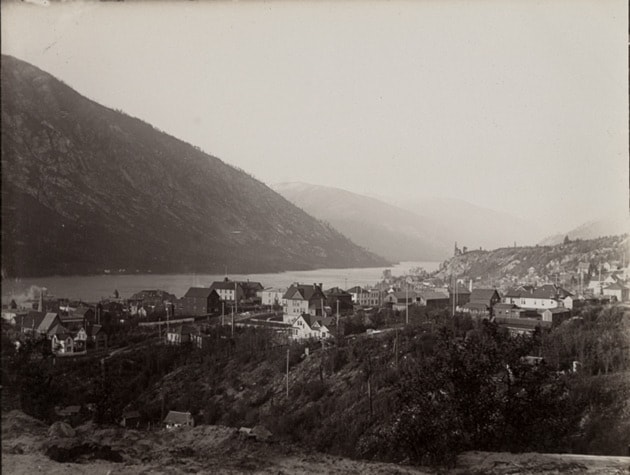A photo collection that has produced some incredible historic images of West Kootenay is now the subject of an exhibit in North Vancouver.
Nanitch: Early Photographs of BC from the Langmann Collection opened this month at Presentation House Gallery and is on until June 26.
It features rare photos drawn from the 18,000 that Uno Langmann donated to the University of BC library in 2014, and spans the 1860s to the 1920s.
This is the same collection that produced photos of the Porto Rico Hotel from 1898 and an album’s worth of pictures of Kuskonook. Previously only two photos of that Kootenay Lake boomtown were known to exist.
Langmann, 80, has been collecting historical BC photos since arriving here in 1955. He and daughter Jeanette told me they were thrilled to see the work of East Shore resident Howard Boyle, who painstakingly identified the exact locations of the Kootenay Lake photos and produced a then-and-now video that will give you goosebumps.
UBC has been digitizing the Langmann collection and you can view it at collections.library.ubc.ca/featured-collections/langmann.
STAFF HOUSE STUFF: FortisBC is willing to listen to ideas for preserving its historic South Slocan staff house — but demolition still remains a high probability.
The building isn’t part of the company’s plans once its new operations centre opens in Ootischenia in the latter part of 2017.
A group has organized informally to brainstorm what to do with it, but if the building is to remain in its current location, FortisBC will have to be satisfied that its use is compatible with their ongoing power generation operations.
That may not be an easy hurdle to overcome, but a Facebook site has been set up at facebook.com/groups/FriendsofSouthSlocanStaffHouse.
I’m grateful to Castlegar historian Walter Volovsek for determining that construction on the building began on Sept. 10, 1926 and to West Kootenay Power retiree Al Craft for loaning me his back issues of Hi-Lines, the company newsletter.
In the February 1988 edition, the late Dave Macdonald provided a brief history of the building and gardens. He indicated the staff house opened Jan. 26, 1932, with president Lorne Campbell signing the register.
I suspect this was actually when the building became a guest house, but I couldn’t find anything about it one way or the other in the Nelson Daily News for that date.
Macdonald added: “Mickey Bryne, who was to hold sway as major-domo of the staff house until his retirement in 1946, was assigned Suite 5. With the opening of the staff house, the gardens were started by Alec McGibbon, who came from the Deadman’s Lake area near Oliver. Alec also planted the ivy that still covers the building.”
The building was converted to its presence use as an office building in 1986.
MARIJUANA CREEK CEDAR: More than a few eyebrows must have been raised in the Lardeau Valley when it became known that Dale Kooner was growing medicinal marijuana on the former Meadow Creek Cedar mill site.
While most residents probably don’t have a problem with medical pot — and with marijuana’s impending legalization, it might all be moot anyway — I can understand how they would nevertheless be baffled that Kooner obtained a license and wonder who he’s growing it for.
On the other hand, despite Kooner’s mismanagement of his forest license, several people commented online that if he’s living up to his marijuana license (RCMP have indicated as much, although I have yet to speak with them), we should just leave him alone.
Maybe his grow operation will be more successful than his lumber company, but I doubt it.
MACDONALD’S MEMOIR: Former Nelson city councillor Donna Macdonald’s book Surviving City Hall, launched this month, is not a tell-all. But it does critique the leadership styles of the five mayors she worked with: Gerald Rotering, Bill Ramsden, Gary Exner, Dave Elliott, and John Dooley, whom she dubs The Schmoozer, The Facilitator, The People Pleaser, The Autocrat, and The Innovator — but not in that order. (I’ll let you guess who’s who. You can read the book to confirm your suspicions.)
It’s one of the meatiest parts of the book, although meatier still are her accounts of her two mayoral campaigns (and the revelation she nearly ran a third time before being talked out of it), plus her thoughts about why women remain underrepresented in politics.
She also admits to initially feeling conflicted about Deb Kozak’s election as mayor in 2014, since it was a job she coveted. But Kozak paid tribute on election night to Macdonald for paving the way, and Macdonald says she’s now “delighted” Nelson finally has its first woman mayor.
An excerpt will appear in this week’s West Kootenay Advertiser.
POLITICAL THRILLERS: Macdonald’s book is one of a few by or about local politicians.
The first was Maurice Hodgson’s The Squire of Kootenay West (1976), a biography of longtime MP Bert Herridge. In 2012, former New Denver mayor Gary Wright published Unrepentent: The Story of An Era, which discussed his lengthy political career though it wasn’t solely focused upon it.
Macdonald’s book is actually the second about a woman on Nelson city council, following Frances Welwood’s Passing Through Missing Pages (2011). It’s the biography of Annie Garland Foster, who in 1920 became the first woman elected to council and two years later was the first to run for mayor. She also had a secret that was expunged from her memoir, hence the book’s title.
